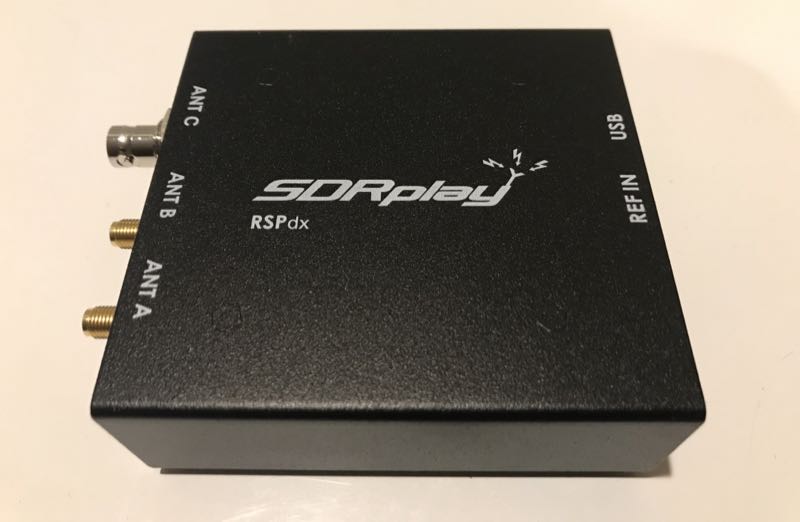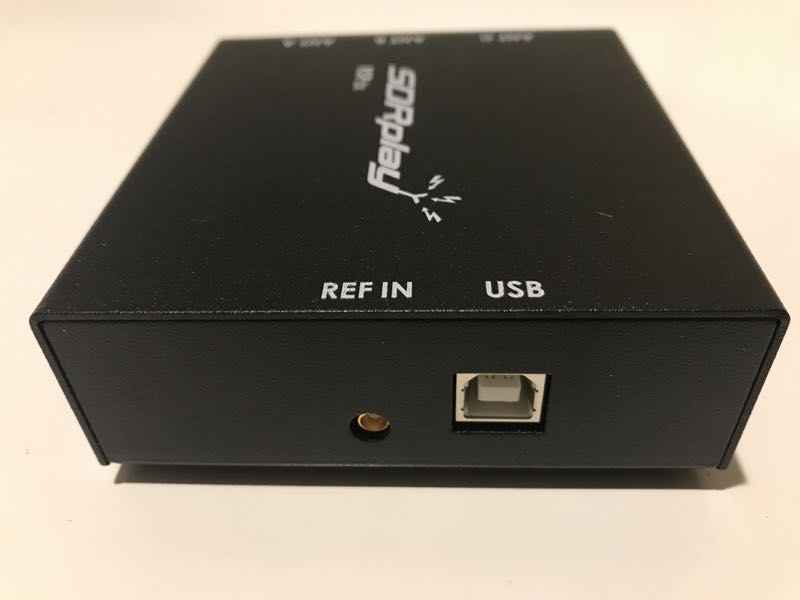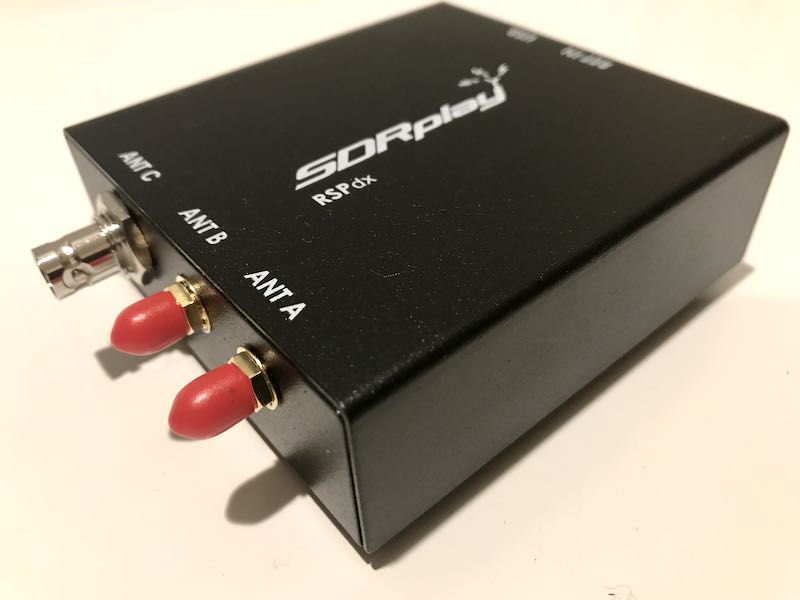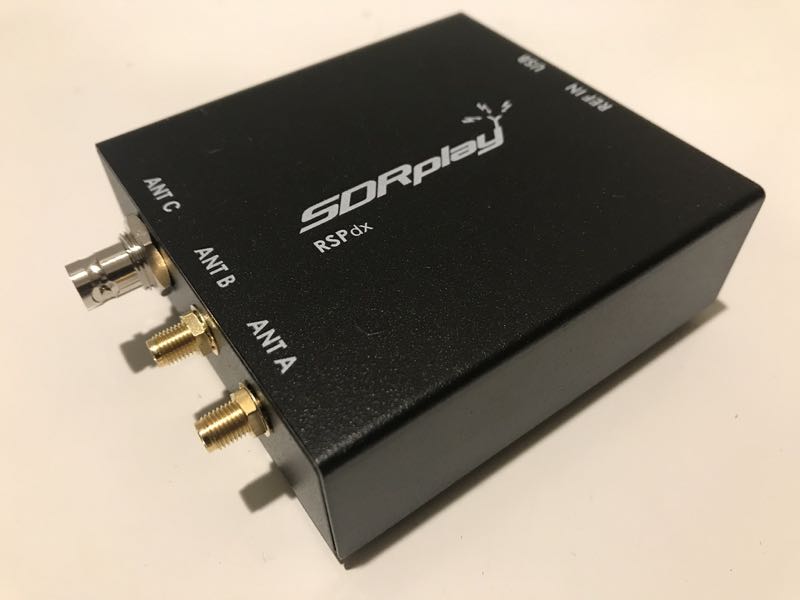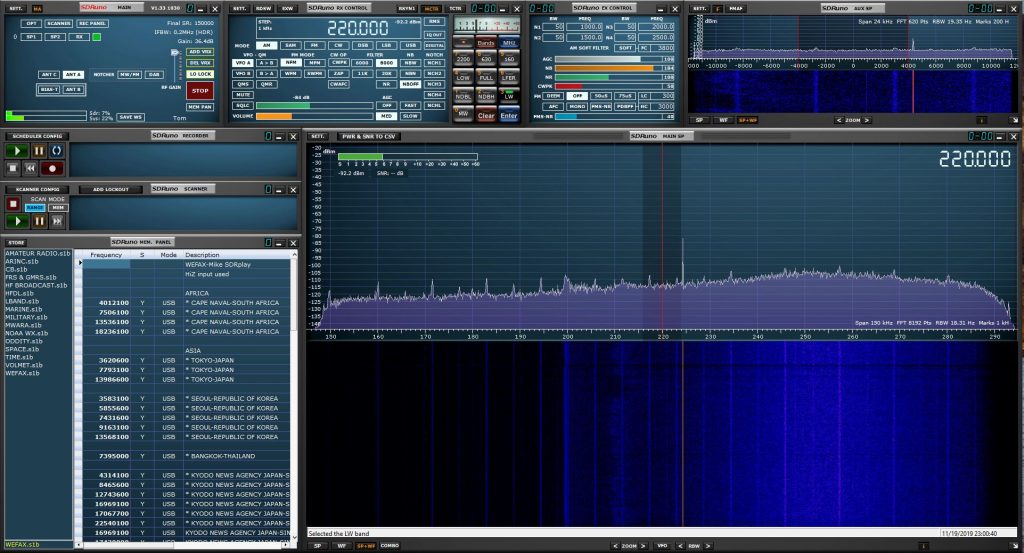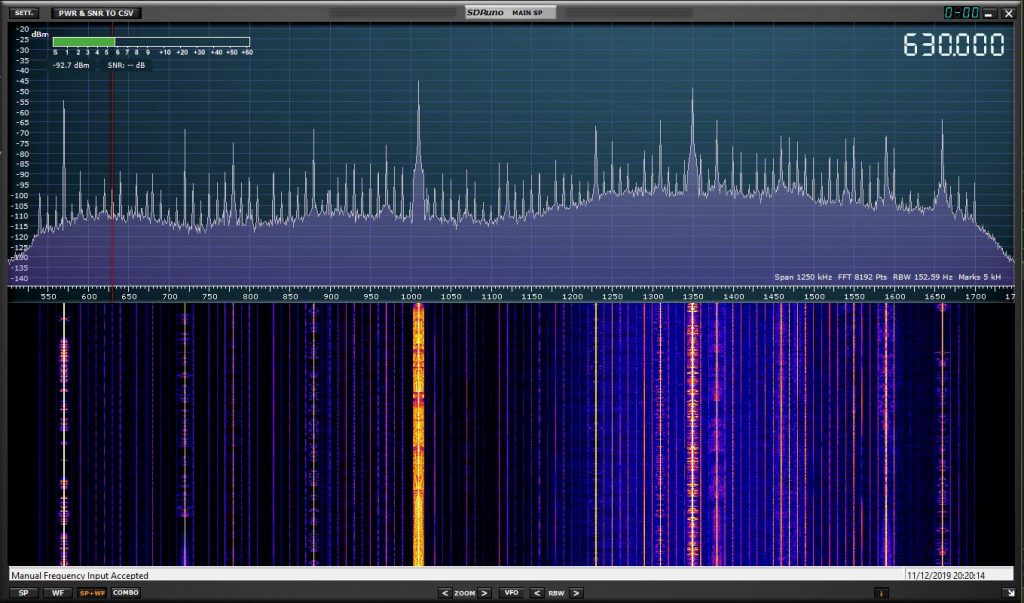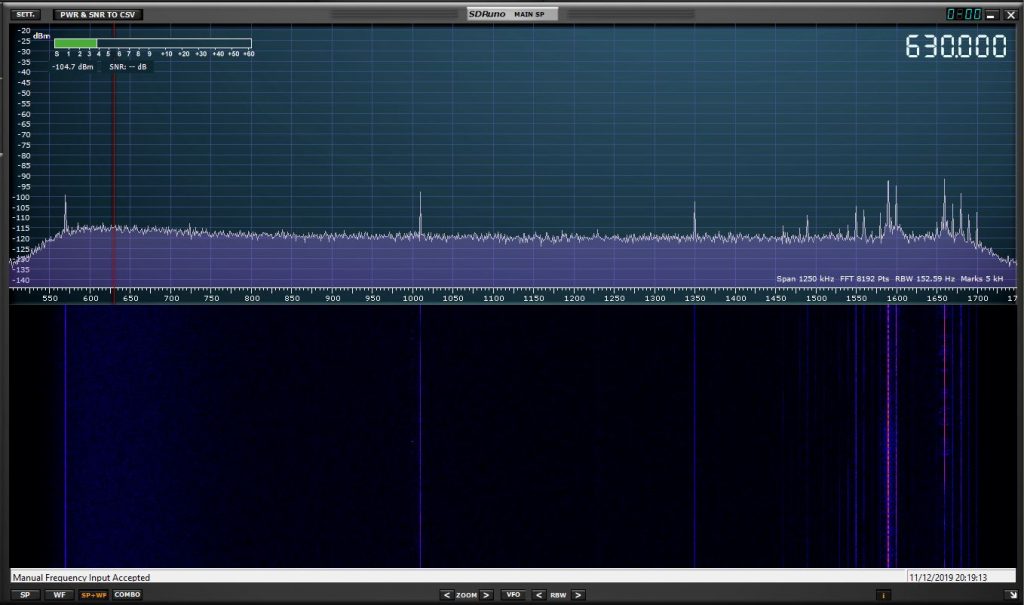SDRplay recently announced the latest product in their line of affordable 14 bit wideband SDRs: the SDRplay RSPdx.
For over two weeks now, I’ve had an early production model of the RSPdx here in the shack operating on a beta version of the SDRuno application.
In the spirit of full disclosure, SDRplay is a long-time supporter of the SWLing Post and I have alpha- and beta-tested a number of their products in the past. This early production RSPdx was sent to me at no cost for a frank evaluation, and that’s exactly what I’ll offer here. To be clear, while I am using beta software, this is not a beta SDR, but one from a first limited production run.
And thus far, I must say, I’m impressed with the RSPdx.
Upgrades
The RSPdx has been introduced as a replacement for the RSP2 and the RSP2pro receivers. It has been updated and upgraded, with a completely new front-end design.
Here are the highlighted improvements and changes:
- Performance below 30 MHz has been enhanced when compared to the RSP2/RSP2pro.
- Performance below 2 MHz has been substantially upgraded. Through the use of the new HDR mode, both dynamic range and selectivity have been considerably improved.
- There is now a BNC antenna connector on antenna C position instead of a HiZ port. Both A and B antenna ports are SMA like other RSP models.
Let’s face it: those of us interested in low-cost SDRs are spoiled for choice these days. The market is chock-full of sub-$200 SDRs, especially if you include all of the various RTL-SDR-based SDRs and knock-off brands/models one can find on eBay.
Personally, I invest in companies that support radio enthusiasts for the long haul…those that do their own designs, innovations, and production. SDRplay is one of those companies.
SDRplay’s market niche has been providing customers with affordable, high-performance wideband receivers that cover an impressive 1 kHz to 2 GHz.
Wideband coverage can come at a cost. Unless you pay big money for a commercial-grade wideband receiver, you’re going to find there’s a performance compromise somewhere across the spectrum. On the RSP2 series, those compromises would have been most apparent on frequencies below 30 MHz.
That’s not to say HF, MW, and LW performance was poor on the RSP2 series–indeed, it was quite impressive and well-balanced; it just didn’t stack up to the likes of the similarly-priced AirSpy HF+ and HF+ Discovery, in my humble opinion. Both little Airspy SDRs have wooed DXers with their impressive dynamic range and overall ability to work weak signals in the HF portion of the spectrum.
Neither of the AirSpy HF+ models are wideband receivers, but still offer a generous range: 9 kHz to 31 MHz and from 60 to 260 MHz––about 11.5% of the frequency coverage of RSP models. (Note that the Airspy R2 and Mini do cover 24 – 1700 MHz.) For shortwave radio listeners that also want to venture into the UHF and SHF regions, a wideband SDR is still required.
It’s obvious SDRplay’s goal is to make the wideband RSPdx into a choice receiver for HF and, especially, for MW/LW DXers. But have they succeeded? Let’s dive in…
Performance
As I say in most of my SDR reviews: doing comparisons with receivers that have so many features and adjustments is never easy. In other words, we want an apples-to-apples comparison, but it can be difficult to achieve, especially with new products.
I compared the SDRplay RSPdx with the WinRadio Excalibur and Airspy HF+ Discovery. Here’s how I set up my comparisons:
The RSPdx, Excalibur, and HF+ Discovery all used the same antenna in my tests––a large, horizontal delta loop antenna, via my ELAD ASA15 amplified antenna splitter. I’ve used this antenna splitter for years and can vouch for its equitable, lab-grade distribution of signal.
The RSPdx is not in full production at time of posting, thus application options are limited. Typically, I’d load comparison SDRs in SDR Console or HDSDR and test them with identical settings as well. At present, the RSPdx is only compatible with a beta version of SDRplay’s own application, SDRuno (which will come out of beta rior to the first major production run). The benefit of using SDRuno is that you unlock the full potential of the RSPdx, plus signal and noise numbers are incredibly accurate.
For each SDR in this comparison, I used their native/OEM application to give them the best possible performance.
I also matched filter settings and made an effort to match AGC and volume settings as closely as I could.
Additionally, I resisted the temptation of comparing my RSP2 with the new RSPdx because I didn’t want to run two simultaneous instances of SDRuno on the same computer––especially considering one was in beta.
Is this comparison perfect? Probably not, but I did the best with the time I had available. I do intend to make further comparisons in the future.
Longwave performance
Via the RSPdx’s new “HDR” mode, both dynamic range and selectivity have been considerably improved with frequencies below 2 MHz. While I’ll fully admit that I’m not much of a longwave DXer, my very first listening session with the RSPdx started in this region of the spectrum.
In fact, the first evening I put the RSPdx on the air and confirmed that I was, indeed, in HDR mode, I noticed a small carrier via the spectrum display on 171 kHz. I clicked on it and quickly discovered it was Medi 1. The signal was faint, but I could clearly ID at least one song. This truly impressed me because I believe this was the first time I had logged Medi 1 on longwave from the shack.
I didn’t connect the Excalibur at that point to see if it could also receive the faint Medi 1 signal, but I imagine it could have. I’m pretty sure this would have been outside the reach of the RSP2, however.
I tried to explore more of the longwave band, but due to local RFI (I suspect an appliance in my home), most of the LW band was inundated with noise. With that said, I did grab three of my benchmark non-directional beacons.
Obviously, the RSPdx is a capable LW receiver. I would like to spend more time on this band once I’ve tracked down the source of my local RFI.
Mediumwave/AM performance
 In the past two weeks, I’ve spent many hours with the RSPdx on mediumwave.
In the past two weeks, I’ve spent many hours with the RSPdx on mediumwave.
We’re heading into the winter months in the northern hemisphere, and that’s normally when my listening habits head south on the bands.
In short: I find the RSPdx to be quite sensitive and selective on the mediumwave bands while the HDR mode is engaged. A major improvement over its predecessor.
I primarily compared the RSPdx with my WinRadio Excalibur on mediumwave since I consider the Excalibur to be a benchmark MW receiver. And, as you’ll hear in the screencasts below, the RSPdx truly gives the Excalibur a run for its money:
740 AM – RSPdx vs. Excalibur:
860 AM – RSPdx vs. Excalibur:
Note that my horizontal delta loop antenna is omni-directional, hence the tug-of-war you hear between stations in the clips above.
In truth, I could have done more to stabilize the signal on both of these fine SDRs, but I wanted to keep the comparison as fair as possible.
You might have noticed that both were running AM sync mode. It seems the sync lock on the RSPdx may have also improved––though I would need to do a direct comparison with the RSP2 to know for sure––but in terms of stability, I still found that the WinRadio Excalibur was superior. Mind you, the Excalibur is a $900 – $1,000 receiver and has the strongest synchronous detector of any radio I’ve ever owned.
Shortwave/HF
SDRplay notes on the preliminary specifications sheet that the RSPdx has been “enhanced” when compared with the RSP2 series.
And, after having spent two weeks with the RSPdx on the shortwave bands, I would say this is a bit of an understatement. For although I haven’t compared the RSPdx directly with the RSP2 yet, I do feel HF performance is substantially better than its predecessor. Indeed, in my comparisons, I often found it gave the Excalibur some serious competition. Overall, the Excalibur had an edge on the RSPdx, but the gap has closed substantially. That’s saying something.
For the comparison videos below, I also included the excellent AirSpy HF+ Discovery.
40M LSB – RSPdx vs. HF+ Discovery:
80M USB – RSPdx vs. Excalibur:
31M Broadcast – RSPdx vs. HF+ Discovery:
As you can see and hear, the RSPdx is now in the league of some of the finest HF receivers in my arsenal.
But I’m curious to know what you think after listening to these comparisons. Please comment!
Notch Filters
For those of you living in areas with DAB/DAB+ broadcasters nearby, you’ll be happy to note that the RSPdx has a DAB filter to help mitigate any potential overloading.
Also, if you live near a blowtorch mediumwave station, you’ll be quite pleased with the MW notch filter. It’s so effective at filtering out the mediumwave band, my local blowtorch on 1010 kHz is barely visible on the spectrum once the notch filter is engaged. (Note: I should add that neither the DAB nor the mediumwave notch filter was engaged during any of my previous comparisons above.) Check out the screen shots below showing the mediumwave band before and after the MW notch filter is engaged:
Before:
After:
Summary
For those of you looking for a budget wideband SDR with solid performance below 30MHz, look no further.
For $199 US, you’re getting a quality UK-designed and manufactured SDR in a proper metal housing. The OEM application, SDRuno, is one of my favorite SDR applications and can fully take advantage of the RSPdx’s new HDR mode. No doubt, with a little more time, most third-party SDR applications will also support the RSPdx.
Frankly, I was expecting classy mediumwave and longwave performance as this was the most touted upgrade of the RSPdx. SDRplay certainly delivered.
In my experience, SDRplay doesn’t oversell their products. Their preliminary product sheet mentioned improved performance on HF, but their press release didn’t even mention the HF upgrades. And this is where I, in particular, noticed significant improvement. Perhaps this is because I am primarily an SWLer, thus spend a larger portion of my time in the HF region.
SDRplay products also have a mature, robust SDR application via SDRuno. Day to day, I tend to use Simon Brown’s SDR Console as my primary SDR application, since it’s compatible with so many of my SDRs and also offers some of the best recording functionality for those of us who do audio and spectrum archiving. Each time I beta test or review an SDRplay SDR, however, I’m more and more impressed with SDRuno. It’s evolved from being a rather cluttered application to one with a thoughtful, cohesive user interface that’s a joy to use––a product of true iterative agility.
Indeed, after having used SDRuno exclusively these past two weeks, I believe I would consider it as my primary SDR application…if only it had audio recording in addition to spectrum recording, and could run multiple instances with multiple SDRs. Again, given a little time, I wouldn’t be surprised if some of this functionality is eventually integrated.
Questions?
Since many SWLing Post readers already own an SDR, I’m sure some of you will have questions. Let’s address a few of those right now.
Question: “I have an RSP2/RSP2pro. Should I upgrade to the RSPdx?”
My recommendation: If you are a shortwave, mediumwave, or longwave DXer, I would indeed recommend upgrading to the RSPdx. If you primarily use your RSP2 series SDR on frequencies above 30 MHz and only occasionally venture below for casual listening, then I’d keep the RSP2.
Question: “I have an RSP1a. Should I upgrade to the RSPdx?”
My recommendation: If you’ve been enjoying your RSP1a and would like to take your listening/monitoring to the next level, then, yes, I would upgrade. Not only can you take advantage of the RSPdx’s enhanced performance, but the RSPdx affords you three antenna ports, and has a more robust front end.
Question: “I have an RSPduo. Should I buy the RSPdx?”
My recommendation: I’m a big fan of the RSPduo. Unless you’re a dedicated mediumwave/longwave DXer, or you’d just like to add another separate SDR to your radio arsenal, I wouldn’t rush out to buy the RSPdx.
And while I’m offering advice, I’d like to offer my standard two cents on the subject of performance optimization: a radio is only as good as its antenna! If you have a compromised antenna, invest in your antenna before upgrading your radio. You’ll be glad you did.
Conclusion
Happily, I can recommend the SDRplay RSPdx without hesitation. This latest iteration of the RSP series SDR is a proper step forward in terms of performance and functionality––obviously implementing years of customer feedback.
SDRplay also has a proven track record of innovation and customer support. Their documentation, video tutorials, and community are among the best in the industry. Purchase with confidence.
Click here to check out the RSPdx at SDRplay.
Do you enjoy the SWLing Post?
Please consider supporting us via Patreon or our Coffee Fund!
Your support makes articles like this one possible. Thank you!

